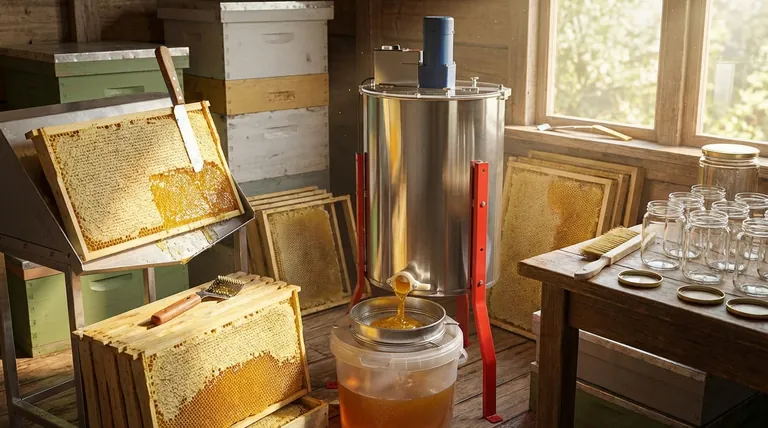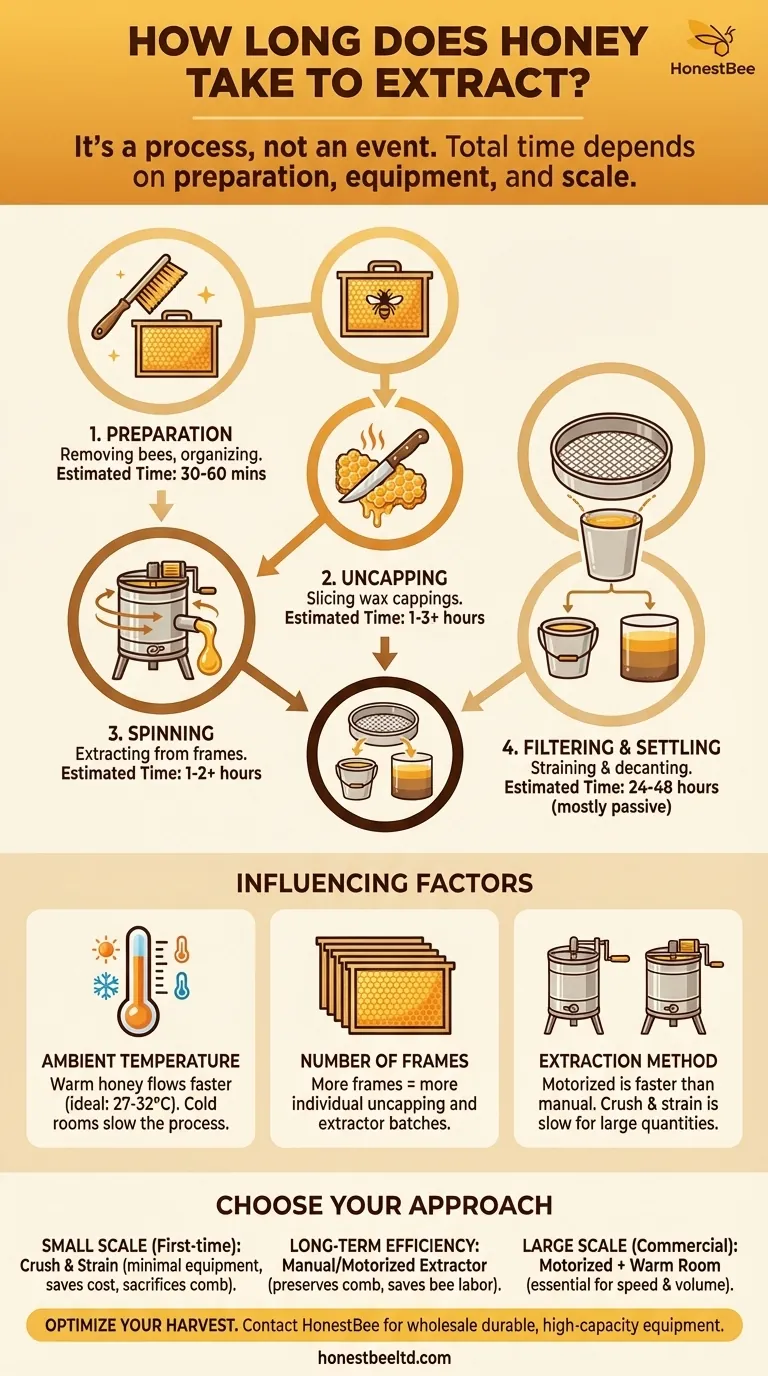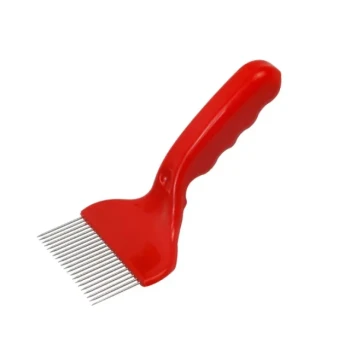The time it takes to extract honey is not a single number, but a function of your process. While the final stage of honey flowing from an extractor into a bucket can take an hour or more, the complete process from removing the frames to bottling the final product is a multi-hour commitment. The total duration is heavily dependent on the number of frames, the ambient temperature, and the specific equipment you use.
The core takeaway is that honey extraction is a process, not a single event. While the mechanical spinning might take an hour, the crucial and often time-consuming steps of preparation, uncapping, and filtering will define the true length of your extraction day.

The Key Stages of Honey Extraction
Understanding the full workflow is essential for accurately estimating your time commitment. Each stage requires focus and adds to the total duration.
Step 1: Preparing the Frames
Before any honey can be extracted, you must have clean frames. This involves gently removing the bees from the honeycomb, often using a bee brush or a specialized blower.
Step 2: Uncapping the Comb
This is the first true step of the extraction process. Bees seal their honey in the comb with a layer of beeswax, known as capping. You must carefully slice off these wax cappings using a heated knife or a specialized uncapping fork. This can be one of the most time-consuming and meticulous stages.
Step 3: Spinning in the Extractor
Once uncapped, the frames are placed inside a honey extractor. This device uses centrifugal force to sling the honey out of the comb without destroying the comb itself. The honey runs down the walls of the extractor and pools at the bottom. This spinning and collection phase is what typically takes an hour or more to fully drain.
Step 4: Filtering and Settling
The raw honey collected from the extractor will contain small bits of wax and other hive debris. It must be filtered through a sieve or strainer to remove these impurities. After filtering, many beekeepers let the honey sit in a process called decanting, allowing any remaining fine particles or air bubbles to rise to the surface for removal.
Understanding the Factors That Influence Time
Several variables can significantly alter how long your extraction day will be. Acknowledging these will help you plan more effectively.
The Extraction Method
The equipment you use is the single biggest factor. A motorized extractor is significantly faster than a manual, hand-cranked one. The crush and strain method, which involves mashing the comb and letting honey drip through a filter, avoids the need for an extractor but can be slower for large quantities and sacrifices the comb.
The Ambient Temperature
Honey is viscous, and its flow rate is highly dependent on temperature. Warm honey flows much faster than cold honey. Conducting your extraction in a warm room (around 80-90°F or 27-32°C) will dramatically speed up the process of spinning, filtering, and bottling.
The Number of Frames
The relationship is simple: more frames mean more time. Each frame must be handled individually during the uncapping stage, and the capacity of your extractor will determine how many batches you need to run.
Your Level of Preparation
An organized workspace is a fast workspace. Having all your tools, sterilized jars, lids, and collection buckets ready before you begin will prevent delays and streamline the entire process.
Making the Right Choice for Your Scale
Your approach should match your goals and the size of your operation.
- If your primary focus is a small, first-time harvest: The crush and strain method is the most accessible, requiring minimal specialized equipment.
- If your goal is long-term efficiency and preserving comb: Investing in a manual or motorized extractor is the best path forward, as it saves the bees significant work.
- If you need to process a large number of hives: A motorized extractor and a dedicated warm room are essential for completing the job in a reasonable amount of time.
Ultimately, a successful and efficient honey extraction comes from understanding that it is a methodical process, not a race.
Summary Table:
| Stage | Key Tasks | Estimated Time (Varies by Scale) |
|---|---|---|
| Preparation | Removing bees, organizing workspace | 30-60 minutes |
| Uncapping | Slicing wax cappings from frames | 1-3+ hours |
| Spinning | Using an extractor to remove honey | 1-2+ hours |
| Filtering & Settling | Straining debris, allowing honey to settle | 24-48 hours (mostly passive) |
Ready to optimize your honey extraction for maximum efficiency?
For commercial apiaries and beekeeping equipment distributors, time is honey. HONESTBEE supplies the durable, high-capacity equipment you need—from motorized extractors to uncapping tools—to streamline your harvest and increase your yield.
Contact our wholesale team today to discuss how our beekeeping supplies can save you time and scale your operation.
Visual Guide

Related Products
- electric honey extractor honey centrifuge 3 frame honey extractor stainless steel honey frame extractor
- 8-Frame Electric Self-Reversing Honey Extractor Spinner for Commercial Honey Extraction Equipment
- HONESTBEE 72 Frame Industrial Electric Honey Extractor for Beekeeping
- Commercial Electric 12 Frame Honey Extractor Spinner Motorized Honey Extractor
- Electric 8 Frame Honey Spinner Extractor Equipment for Beekeeping
People Also Ask
- What are the two main types of honey extractors? Choose Between Tangential and Radial for Your Apiary
- What happens to the frames after spinning in the extractor? A Guide to Sustainable Frame Management
- What are the steps for honey extraction using a centrifuge? A Guide to Efficient, Comb-Preserving Harvests
- How do automatic honey extractors function? Achieve High-Efficiency Honey Harvesting
- What are the main processes involved in honey processing? From Hive to Jar, A Complete Guide



















